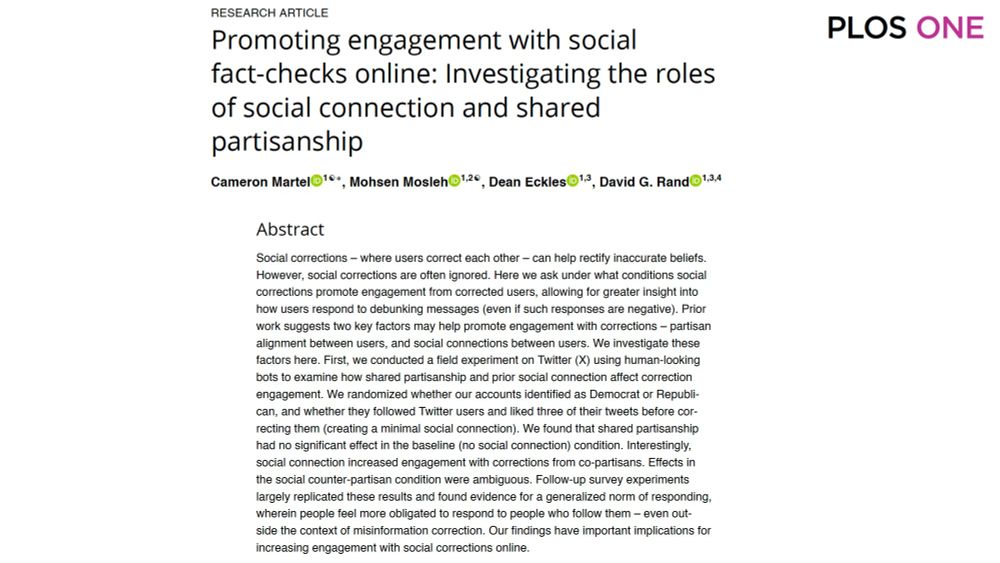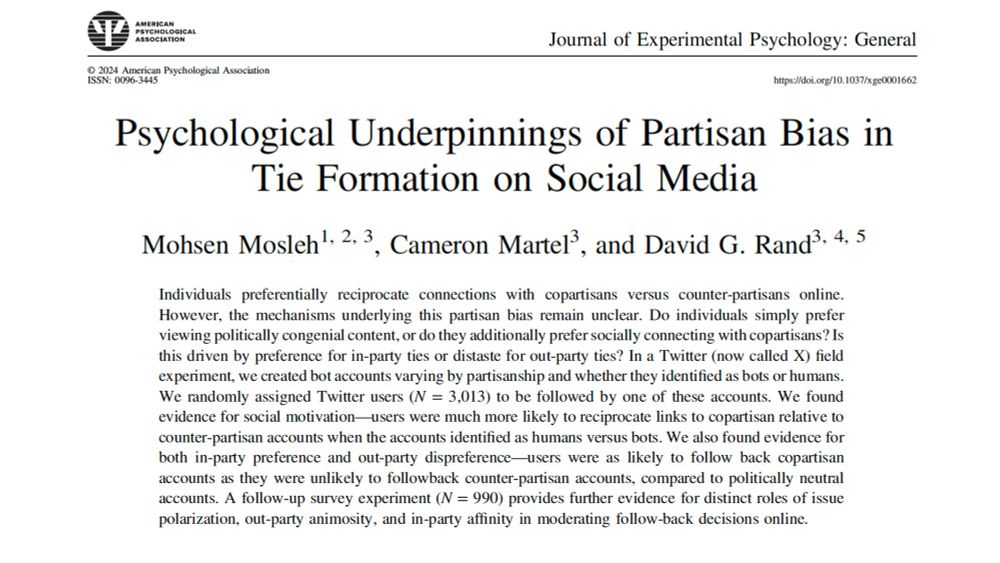
Studies misinformation & inauthentic behavior online.





(i) Among users in the co-partisan condition, social connection had a sig positive effect on engagement
(ii) Among users in the baseline (non-social) condition, no evidence of effect of shared partisanship on engagement

(i) Among users in the co-partisan condition, social connection had a sig positive effect on engagement
(ii) Among users in the baseline (non-social) condition, no evidence of effect of shared partisanship on engagement

We randomized whether our bots
(i) were co-partisan or counter-partisan for the to-be-corrected user
(ii) followed the user & liked some of their tweets before correcting them (creating a minimal social connection)

We randomized whether our bots
(i) were co-partisan or counter-partisan for the to-be-corrected user
(ii) followed the user & liked some of their tweets before correcting them (creating a minimal social connection)
Corrections of misinfo are often ignored. What can drive engagement?
Twitter field exp & survey followups find
-Social ties matter: users more likely to engage w corrections from accounts who followed user
-Shared partisanship had smaller effects on engagement
shorturl.at/0Ycdp

Corrections of misinfo are often ignored. What can drive engagement?
Twitter field exp & survey followups find
-Social ties matter: users more likely to engage w corrections from accounts who followed user
-Shared partisanship had smaller effects on engagement
shorturl.at/0Ycdp
-Information & making friends were most mentioned as follow-back reasons
-Curiosity also oft mentioned, esp for counter-partisan follow-back
-Not wanting info (esp from counter-partisans) & id’ing account as a stranger were most mentioned rzns for ignoring accounts

-Information & making friends were most mentioned as follow-back reasons
-Curiosity also oft mentioned, esp for counter-partisan follow-back
-Not wanting info (esp from counter-partisans) & id’ing account as a stranger were most mentioned rzns for ignoring accounts
-50% of ppl in co-partisan condition who followed-back account mentioned same partisanship as motivation
-58% of ppl in counter-partisan condition who ignored account mentioned diff partisanship as motivation

-50% of ppl in co-partisan condition who followed-back account mentioned same partisanship as motivation
-58% of ppl in counter-partisan condition who ignored account mentioned diff partisanship as motivation
In contrast, ppl w ⬆️ in-party affinity were more likely to follow-back neutral & co-partisans, relative to counter-partisans

In contrast, ppl w ⬆️ in-party affinity were more likely to follow-back neutral & co-partisans, relative to counter-partisans
-Pref follow-back of co-partisan vs counter-partisan explicit bot accounts (ev of simple content prefs)
-Even *greater* pref follow-back in human-looking vs bot accounts (ev of additional social motivation)

-Pref follow-back of co-partisan vs counter-partisan explicit bot accounts (ev of simple content prefs)
-Even *greater* pref follow-back in human-looking vs bot accounts (ev of additional social motivation)

Why do ppl preferentially reciprocate follows by co-partisans online? In a Twitter field exp & online survey exp we find:
-Both content *and* social prefs drive co-party tie-making
-Distinct roles for in-party pref & out-party dispref
dx.doi.org/10.1037/xge0...

Why do ppl preferentially reciprocate follows by co-partisans online? In a Twitter field exp & online survey exp we find:
-Both content *and* social prefs drive co-party tie-making
-Distinct roles for in-party pref & out-party dispref
dx.doi.org/10.1037/xge0...

-Decrease sharing of false headlines on average (24.7%⬇️)
-Are similarly effective for those w greater trust in FCs
-Still work on those in lowest quartile trust in FCs
-Still work on those maximally distrusting of FCs (16.7%⬇️)

-Decrease sharing of false headlines on average (24.7%⬇️)
-Are similarly effective for those w greater trust in FCs
-Still work on those in lowest quartile trust in FCs
-Still work on those maximally distrusting of FCs (16.7%⬇️)
-Decrease belief in false headlines on average (27.6%⬇️)
-Are more effective for those w greater trust in FCs
-Still work on those in lowest quartile trust in FCs
-Still work on those maximally distrusting of FCs (12.9%⬇️)

-Decrease belief in false headlines on average (27.6%⬇️)
-Are more effective for those w greater trust in FCs
-Still work on those in lowest quartile trust in FCs
-Still work on those maximally distrusting of FCs (12.9%⬇️)



Will misinfo warning labels backfire for ppl who distrust fact-checkers? No!
Labels reduce belief in & sharing of false news even for those highly distrusting of fact-checkers - warning labels are a key tool for platforms!
rdcu.be/dSHtF

Will misinfo warning labels backfire for ppl who distrust fact-checkers? No!
Labels reduce belief in & sharing of false news even for those highly distrusting of fact-checkers - warning labels are a key tool for platforms!
rdcu.be/dSHtF





